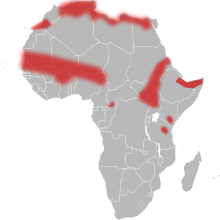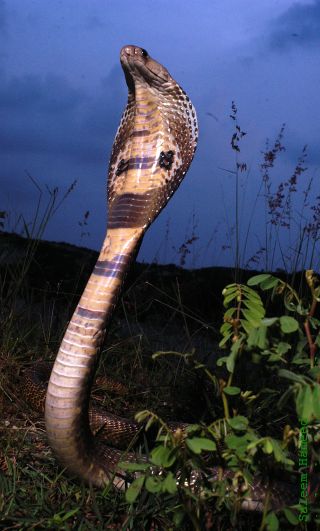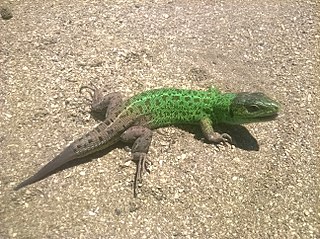Naja haje
| Naja haje | |||||||||||||
|---|---|---|---|---|---|---|---|---|---|---|---|---|---|
 | |||||||||||||
| Korunma durumu | |||||||||||||
 Asgari endişe altında (IUCN 3.1)[2] | |||||||||||||
| Biyolojik sınıflandırma | |||||||||||||
| |||||||||||||
| İkili adlandırma | |||||||||||||
| Naja haje | |||||||||||||
 | |||||||||||||
| Sinonimler [3] | |||||||||||||
| |||||||||||||
Naja haje, Naja cinsine bağlı zehirli bir yılan türüdür.[4][5]
Etkenleri
Zehri, ağırlıklı olarak sitotoksin ve nörotoksinlerden oluşur.[6] Tek seferdeki ortalama zehir 175–300 mg'dır ve farelerdeki deri altı ortalama öldürücü dozu 1,15 mg/kg'dır.[7]
Konuyla ilgili yayınlar
- Linnaeus, C. Systema naturæ per regna tria naturæ, secundum classes, ordines, genera, species, cum characteribus, differentiis, synonymis, locis. Tomus I. Editio decima, reformata.
- David, Patrick, and Ivan Ineich, 1999: Les serpents venimeux du monde: systematique et repartition. Dumerilia, vol. 3. 3-499.
- Broadley, D.G. (1958) Snakes of Southern Rhodesia. 6. The Egyptian cobra (Naja haje haje).: Afr. Wild Life 12: 125-128.
- Broadley,D.G. (1962) On some reptile collections from the North-Western and North-Eastern Districts of Southern Rhodesia 1958-1961, with descriptions of four new lizards.: Occ. Pap. Nat. Mus. South. Rhodesia 26 (B): 787-843
- Dobiey, M. & Vogel, G. (2007) Venomous Snakes of Africa/Giftschlangen Afrikas.: Terralog 15, Edition Chimaira, Frankfurt am Main, 150 pp.
- Laita, Mark (2013) Serpentine.: Abrams and PQ Blackwell, Auckland, New Zealand, 200
- Schleich, H.H. (1987) Contributions to the herpetology of Kouf National Park (NE-Libya) and adjacent areas.: Spixiana 10 (1): 37-80.
- Scortecci, G. (1932) Rettili dello Yemen.: Atti soc. Ital. Sci.Nat. 71: 39-49
- Spawls, S., Branch,B. (1995) The Dangerous Snakes of Africa.: Blandford, London, 192 pp.
- Trape, J.-F. & Mané, Y. (2006) Guide des serpents d'Afrique occidentale. Savane et désert. [Senegal, Gambia, Mauritania, Mali, Burkina Faso, Niger].: IRD Editions, Paris, 226 pp.
- Trape, J.F.; Chirio, L.; Broadley, D.G. & Wüster, W. (2009) Phylogeography and systematic revision of the Egyptian cobra (Serpentes: Elapidae: Naja haje) species complex, with the description of a new species from West Africa.: Zootaxa 2236: 1–25
- Winchell, S. (2011) Kobras.: Reptilia (Münster) 16 (89): 16-22
- Broadley, D.G. (1968) A review of the African cobras of the genus Naja (Serpentes: Elapinae).: Arnoldia (Rhodesia) (ser. 3) 29: 1-14
- Chirio, L. (2009) Inventaire des reptiles de la région de la Réserve de Biosphère Transfrontalière du W (Niger/Bénin/Burkina Faso: Afrique de l'Ouest). [Herpetological survey of the W Transfrontier Biosphere Reserve area (Niger/Benin/Burkina Faso: West Africa].: Bull. Soc. Herp. France (132): 13-41
- Chirio, Laurent and Ivan Ineich (2006) Biogeography of the reptiles of the Central African Republic.: African Journal of Herpetology 55(1):23-59.
- Egan, D. (2007) Snakes of Arabia.: Motivate Publishing, Dubai, 208 pp.
- Hoser, R. (2009) A reclassification of the True Cobras; species formerly referred to the genera Naja, Boulengerina and Paranaja.: Australasian Journal of Herpetology 7: 1-15
- Ineich, I. (1999) Reptiles & Amphibiens de la République de Djibouti.: BNDB, UICN, PNUD, Djibouti & MNHN, Paris, 60 pp.
- Kaiser, H.; Crother, B.I.; Kelly, C.M.R.; Luiselli, L.; O'Shea, M.; Ota, H.; Passos, P.; Schleip, W.D. & Wüster, W. (2013) Best Practices: In the 21st Century, Taxonomic Decisions in Herpetology are Acceptable Only When Supported by a Body of Evidence and Published via Peer-Review.: Herpetological Review 44 (1): 8-23
- Largen, M.J.; Spawls, S. (2010) Amphibians and Reptiles of Ethiopia and Eritrea.: Edition Chimaira, Frankfurt, 694 pp
- Pitman,C.R.S. (1974) A guide to the snakes of Uganda.: Codicote, Wheldon & Wesley, L., 290 pp.
- SANDERS, KATE L.; ARNE R. RASMUSSEN, JOHAN ELMBERG, MUMPUNI, MICHAEL GUINEA, PETER BLIAS, MICHAEL S.Y. LEE & BRYAN G. FRY (2012) Aipysurus mosaicus, a new species of egg-eating sea snake (Elapidae: Hydrophiinae), with a redescription of Aipysurus eydouxii (Gray, 1849).: Zootaxa 3431: 1–18
- Schmidt, K. P. (1923) Contributions to the herpetology of the Belgian Congo based on the collection of the American Museum Congo Expedition, 1909-1915. Part II. Snakes, with field notes by Herbert Lang and James P. Chapin.: Bull. Amer. Mus. nat. Hist. 49 (1): 1-146
- Sinsin B, Bergmans W(eds) (1999) Rongeurs, ophidiens et relations avec l'environnement agricole du Bénin.: Cotonou (Éd. Flamboyant), 199 pp.
- Trape, J.-F. & Mané, Y. (2004) Les serpents des environs de Bandafassi (Sénégal oriental).: Bull. Soc. Herp. France 109: 5-34
- Trape, Jean-François; Mané, Youssouph (2000) Les serpents des environs de Dielmo (Sine-Saloum, Sénégal).: Bull. Soc. Herp. France 95: 19-35
- Venchi, Alberto and Roberto Sindaco (2006) Annotated checklist of the reptiles of the Mediterranean countries, with keys to species identification. Part 2 -Snakes (Reptilia, Serpentes).: Annali del Museo Civico di Storia Naturale "G. Doria", Genova, XCVIII: 259-364
- Wallach, V.; Wüster, W. & Broadley, D.G. (2009) In praise of subgenera: taxonomic status of cobras of the genus Naja Laurenti (Serpentes: Elapidae).: Zootaxa 2236: 26–36
- Wallach, Van; Kenneth L. Williams, Jeff Boundy (2014) Snakes of the World: A Catalogue of Living and Extinct Species.: Taylor and Francis, CRC Press, 1237 pp.
- Bauer, Aaron M.; Branch, William R. & Haacke, Wulf D. (1993) The herpetofauna of the Kamanjab area and adjacent Damaraland, Namibia.: Madoqua (Windhoek) 18 (2): 117-145.
- Boulenger, George A. (1891) Catalogue of the reptiles and batrachians of Barbary (Morocco, Algeria, Tunisia), based chiefly upon the notes and collections made in 1880-1884 by M. Fernand Lataste.: Tr. Zool. Soc. 13: 93-164
- Broadley, D.G. (1959) The herpetology of Southern Rhodesia. Part I--the snakes.: Bull. Mus. Comp. Zool. Harvard 120 (1): 1-100
- Chifundera, K. (1990) Snakes of Zaire and their bites.: Afr. Stud. Monogr. (Kyoto) 10(3): 137-157
- Chirio, L. & Lebreton, M. (2007) Atlas des reptiles du Cameroun.: MNHN, IRD, Paris 688 pp.
- Haas, Georg (1957) Some amphibians and reptiles from Arabia.: Proc. Cal. Acad. Sci. 29 (3): 47-86
- Lanza, B. (1990) Amphibians and reptiles of the Somali Democratic Republic: check list and biogeography.: Biogeographia, 14: 407-465, 1988
- Peters, Wilhem Carl Hartwig (1873) Über zwei Giftschlangen aus Afrika und über neue oder weniger bekannte Gattungen und Arten von Batrachiern.: Monatsber. königl. Akad. Wiss. Berlin. 1873 (Mai): 411-418
- Razzetti, E. & Msuya, C.A. (2002) Field guide to the amphibians and reptiles of Arusha National Park (Tanzania).: Publ. Ed. Negri Istituto, Oikos, Varese, 84 pp
- TRAPE, JEAN-FRANÇOIS & CELLOU BALDÉ (2014) A checklist of the snake fauna of Guinea, with taxonomic changes in the genera Philothamnus and Dipsadoboa (Colubridae) and a comparison with the snake fauna of some other West African countries.: Zootaxa 3900 (3): 301–338
- van der Kooij, Jeroen (2001) The herpetofauna of the Sultanate of Oman: Part 4: The terrestrial snakes.: Podarcis 2 (2): 54-64
Kaynakça
- ^ "Naje haje haje". ITIS Standard Report Page. ITIS.gov. 4 Mart 2022 tarihinde kaynağından arşivlendi. Erişim tarihi: 13 Ocak 2012.
- ^ Wilms, T.; Wagner, P.; Spawls, S.; Beraduccii, J.; Malonza, P.K. (2021). "Naja haje". IUCN Tehdit Altındaki Türlerin Kırmızı Listesi. 2021: e.T184071A1748178. doi:10.2305/IUCN.UK.2021-2.RLTS.T184071A1748178.en
 . Erişim tarihi: 26 Mayıs 2022.
. Erişim tarihi: 26 Mayıs 2022. - ^ "Naja haje ". The Reptile Database. www.reptile-database.org.
- ^ "GBIF". 14 Mart 2023 tarihinde kaynağından arşivlendi. Erişim tarihi: 9 Ekim 2024.
- ^ "PaleoBioDB". 16 Haziran 2024 tarihinde kaynağından arşivlendi. Erişim tarihi: 9 Ekim 2024.
- ^ Joubert, FJ; Taljaard N (October 1978). "Naja haje haje (Egyptian cobra) venom. Some properties and the complete primary structure of three toxins (CM-2, CM-11 and CM-12)". European Journal of Biochemistry. 90 (2): 359-367. doi:10.1111/j.1432-1033.1978.tb12612.x. PMID 710433.
- ^ Fry, Dr. Bryan Grieg. "Sub-cutaneous LD-50s". Australian Venom Research Unit. University of Queensland. 13 Nisan 2012 tarihinde kaynağından arşivlendi. Erişim tarihi: 14 Ocak 2012.
Dış bağlantılar
 Wikimedia Commons'ta Naja haje ile ilgili çoklu ortam belgeleri bulunur.
Wikimedia Commons'ta Naja haje ile ilgili çoklu ortam belgeleri bulunur. Vikitür'de Naja haje ile ilgili ayrıntılı taksonomik bilgiler bulunur.
Vikitür'de Naja haje ile ilgili ayrıntılı taksonomik bilgiler bulunur.
















